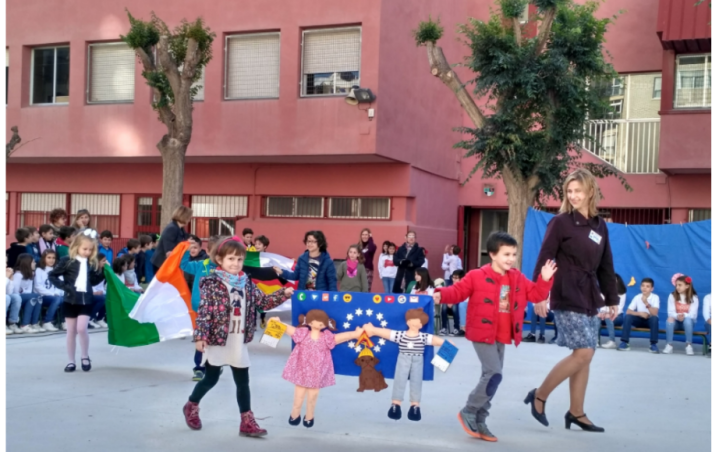Topic(s) addressed
The topics addressed by this project were directly linked to EITA’s annual priority topics of i) new innovative curricula/educational methods/development of training courses, and ii) ICT - new technologies and digital competences. Both topics were implemented using a work plan to meet the primary objectives of strengthening the use of audio-visual and digital media in the teaching and learning processes of both kindergarten and primary school pupils; increasing the use of ICT in teaching and learning process (especially with foreign languages); and, improving the inclusion and learning of students with special needs by diminishing the “digital gap.”
Target groups
The project’s target groups consisted of more than 60 teaching staff from five countries (Spain, Germany, Ireland, Italy, and Portugal), as well as students between the ages of 3-11 from various backgrounds (comprising disabled and refugee students), including a substantial number of students with special needs and specific learning requirements. Teaching staff included resource teachers, ICT teachers, special-needs teachers, and linguistic support teachers.
Methodologies
The project adopted a multidisciplinary approach to ICT development within kindergartens and primary schools, and saw the participation of teachers from various subject areas. Aimed at addressing inequality at an early stage, the project’s activities and materials were designed on the concept on inclusivity so as to enable all students to learn and utilise ICT within their respective learning processes. Given the differing age groups among participants, various strategies were employed with regard to the incorporation of digital competences, with implementation carried out in a transversal manner across different curricula through the use of a structured, coherent, and sequenced approach from kindergarten up until primary education. A well-regulated plan was conceived for the teaching of digital competences, as well as a 'Didactic Digital Guide' that contains various devices, tools, and activities that students could carry out depending on their age or competence.
Environments
The design and implementation of the project’s activities adopted a ‘whole school’ approach, given that the project’s aim was to impact both kindergarten and primary school teachers and students. To this end, not only was the Didactic Guide compiled to action an innovative methodological shift within the teaching practices of the school’s staff, it was also conceived as a tool that objectively measured students’ progress of sequenced syllabus in their journey to achieve digital competence. The development of these objectives among European partners resulted in a solid and useful network that allowed (and which continues to allow) both students and teachers to benefit from the exchange and learning of new and different ways through which to integrate ICT into the teaching and learning process. The project’s digital activities functioned as a unifying thread that allowed learners to develop their respective social competences (by learning about partners’ environments and cultures) as well as their foreign language competences (through the use of English as a working language). The acquisition of both competences was essential in developing an awareness of European citizenry that facilitated students’ interaction with other European peers from an early age.
Teachers
The project enabled exchange and interaction among high- and low-skilled ICT teachers, which was facilitated by the project coordinator who, by encouraging creativity, innovation, and consistency, ensured the formation of a motivated work group. All activities were planned so as to encourage cooperation, with the exchange of knowledge, experience, and good practices forming the project’s core principles. The project’s success was entirely a result of this cooperative methodology and a regular peer-review process, with virtual collaborative spaces having played a critical supporting role. Teachers’ ability to successfully integrate digital tools into the classroom environment to suit students’ age and tool typology was itself a direct reflection of the project’s robust methodology, which was built on practices such as self-training, peer-learning, experience-exchange, and continuous training. Moreover, students were allowed to work together in developing their materials, which was then shared on a website that was developed specifically for the purpose of dissemination.
Impact
The project resulted in the development of a fully sequenced didactic programme on digital competencies for both kindergartens and primary schools that has since been exported to other schools, and which has served as a template for ICT development by other teachers and students. As a result of the project’s collaborative approach, the developed programme subsumes didactic considerations from a number of schools, including learning standards, objectives, contents, assessment criteria and tools, basic competences, resources, and timing, with the ICT school guide itself being freely-available for download from the school’s website. Part of the project’s innovation processes included development and assistance for several ICT training activities (both online and in the classroom), which included seminars and workshops that were implemented during the various planned mobilities. Lastly, an ICT expert from each participating school was responsible for the planning and teaching of activities that were aimed at impacting at every step of the teaching and learning process.
Photos: https://erasmusplanningict.com/?page_id=998
- Reference
- 2017-1-ES01-KA219-037849
- Project locations
- Spain
- Project category
- Early childhood education and care
- Project year
- 2021
Stakeholders
Participants
Agrupamento de Escolas de Vialonga
- Address
- Portugal
Istituto Comprensivo "Maria Montessori"
- Address
- Italy
Scoil na bhForbacha
- Address
- Ireland
Walburgisschule Werl
- Address
- Germany

